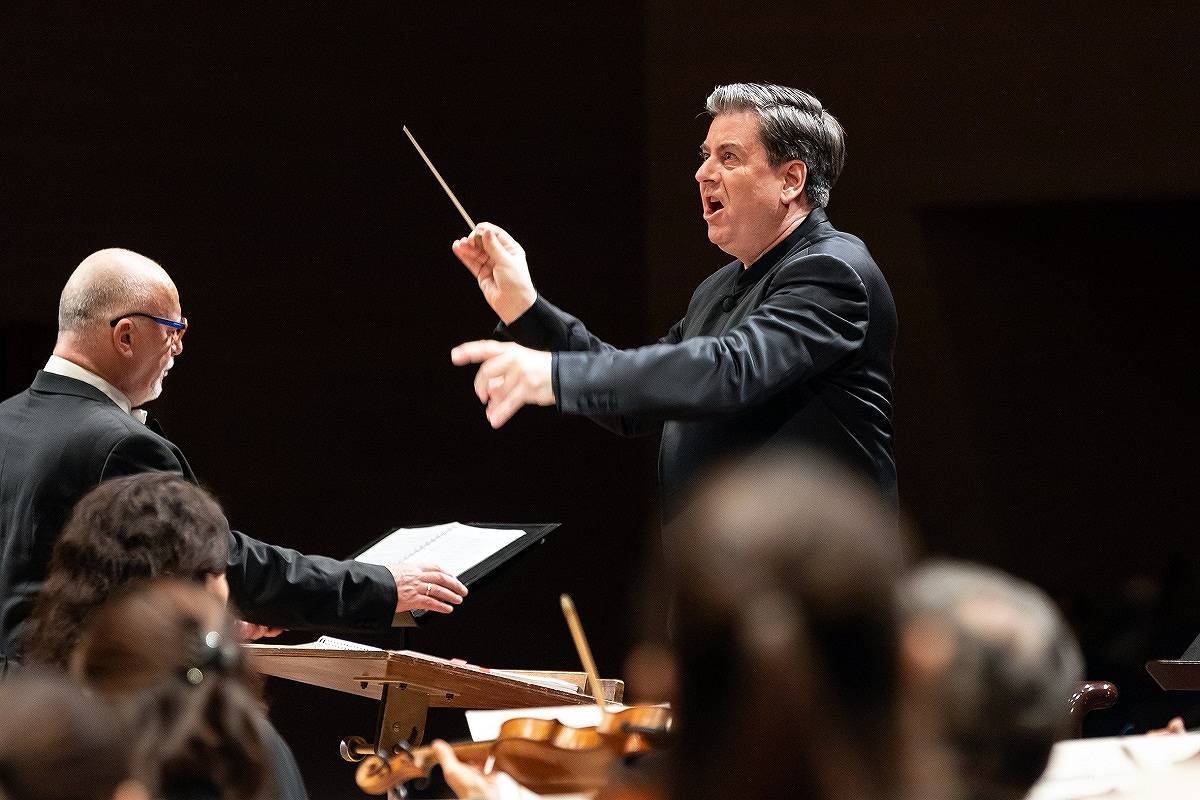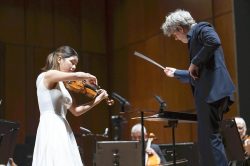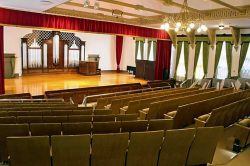
Sebastian Weigle, center, conducts the Japanese premiere of Deutsche Sinfonie with the Yomiuri Nippon Symphony Orchestra at Suntory Hall in Akasaka, Tokyo, on Oct. 17. Bass Falk Struckmann is also seen, left.
11:30 JST, October 29, 2023
In what was one of the most impactful performances of the Yomiuri Nippon Symphony Orchestra’s (YNSO) 2023-24 season, the orchestra, led by Sebastian Weigle, played the Japanese premiere of Deutsche Sinfonie (German Symphony) by Hanns Eisler (1898-1962) at Suntory Hall in Akasaka, Tokyo, on Oct. 17.
Deutsche Sinfonie is by far the largest work by Eisler, who is not as well-known as many other 20th-century composers. As he was half Jewish, Eisler was forced to flee Nazi Germany and immigrated to the United States in the 1930s. He was also a communist, so he had to defect to East Germany after World War II.
The composer died behind the Iron Curtain during the early years of the Cold War and was long forgotten in the West. It was only after the wall came down that people outside the former Eastern bloc discovered his music.
Weigle, who has been the YNSO’s principal conductor since 2019, was born in East Germany and studied at the prestigious Berlin music school Hochschule fur Musik Hanns Eisler, named after the composer. Leading a performance of Deutsche Sinfonie in Japan was a dream come true for the conductor.
The concert opened with Paul Hindemith’s Theme and Variations “The Four Temperaments” for piano and string orchestra. Hindemith (1895-1963) was Eisler’s contemporary and had a successful career in West Germany. They both strived to handle the new musical languages of the early 20th century in their own distinct ways. Pianist Lukas Geniusas’ performance blended well with the strings, and Weigle was able to perfectly balance the two sounds.
As Geniusas did not appear in the second half of the concert, he delighted the audience with a lovely encore piece, “Alt-Wien,” Triakontameron No. 11, by Leopold Godowsky.
The second half of the concert was devoted to Deutsche Sinfonie. Despite the title, the epic work is not about glorifying Germany but about what the country represented and how it affected its people in the first half of the 20th century.
With 11 movements — eight with voices —it is not a traditional symphony but a statement against the notion of classic German symphonies.
Eisler began composing the opus in 1935, had completed most of it by 1939, and added an epilogue in 1958. The work was performed for the first time in 1959 in East Germany.
Eisler was a student of Arnold Schoenberg, whose 12-tone method opened the way to atonality and a whole range of avant-garde music, but who was against the idea of music becoming something the public could no longer relate to. He wanted to be useful as a composer and wrote music for film, theater and radio. He even composed East Germany’s national anthem.
During the 1930s, however, he briefly returned to using the 12-tone method partly as a way to protest against the Nazis. The technique is also utilized in Deutsche Sinfonie, but it is not as noticeable as he expertly combined it with a variety of musical styles and used regular beats.
The lyrics were written by famed playwright Berthold Brecht, with whom Eisler had a successful professional relationship. The words delve into the anxiety and despair felt by workers, farmers and the mothers of soldiers.
Four illustrious soloists performed during the Japan debut of Deutsche Sinfonie. Mezzo-soprano Christa Mayer sang as if she was speaking to the audience, baritone Dietrich Henschel’s warm tones and bass Falk Struckmann’s solid voice added to the drama of the piece, and soprano Anna Gabler gave a heart-wrenching performance of a mother grieving for her son and feeling cold and exhausted in the brief epilogue.
The engaging chorus was provided by the New National Theatre Chorus.
As the rather abrupt ending of the short epilogue took the audience off guard, the audience was hesitant to applaud at first, as they were not sure if it was really over. But once it became obvious, the hall erupted with loud applause that seemed to last for minutes.
Weigle thanked all the performers on stage and asked each section of the orchestra to stand up and receive recognition.
The date was decided some time ago, but the timing of the concert, given what is currently happening in the world, made the meaning of the opus reverberate that much more strongly. The intensity of the performance was enough to make the audience shudder and think.
"Culture" POPULAR ARTICLE
-

Van Cleef & Arpels Dazzles with Art Deco Artisanry at Tokyo Exhibit
-

Disney’s ‘Twisted-Wonderland’ Animated Series Puts Villains in Spotlight: New Show Features School Inspired by Classic Disney Films
-

Japan Plans to Distribute Manga Overseas Via New Platform
-

Japanese Craftsman Produces Beautiful and Durable Bags Made of Wood
-

Ayumi Hamasaki’s Shanghai Concert Canceled Day Before Schedule as Part of Beijing Backlash
JN ACCESS RANKING
-

Keidanren Chairman Yoshinobu Tsutsui Visits Kashiwazaki-Kariwa Nuclear Power Plant; Inspects New Emergency Safety System
-

Imports of Rare Earths from China Facing Delays, May Be Caused by Deterioration of Japan-China Relations
-

University of Tokyo Professor Discusses Japanese Economic Security in Interview Ahead of Forum
-

Japan Pulls out of Vietnam Nuclear Project, Complicating Hanoi’s Power Plans
-

Govt Aims to Expand NISA Program Lineup, Abolish Age Restriction
























